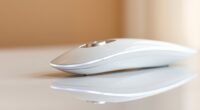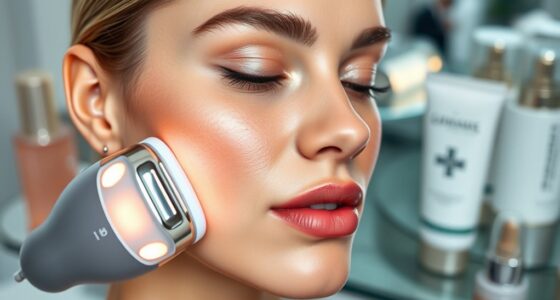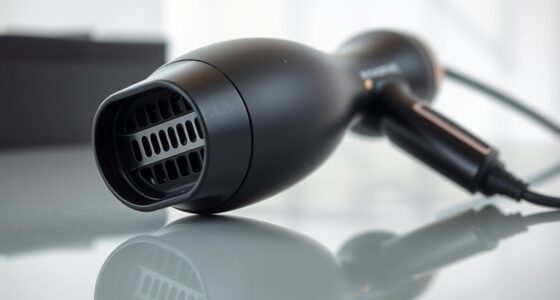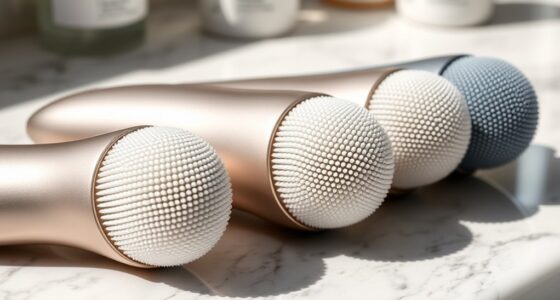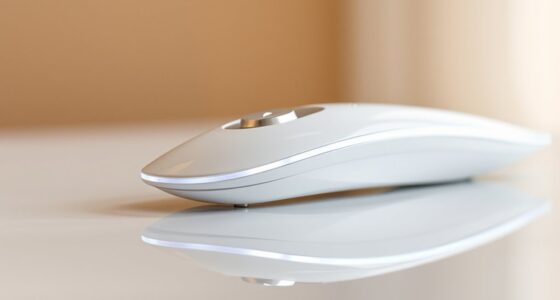LED face masks use specific light wavelengths to target skin issues like wrinkles and acne, but they don’t replace professional treatments. Red light can boost collagen and improve firmness over time, while blue light helps reduce mild acne. However, visible results depend on consistent use, and they don’t address deeper concerns or underlying conditions. If you want to understand what these devices can truly do and their limits, keep exploring more about how they work.
Key Takeaways
- LED face masks emit specific wavelengths like red and blue light to target skin concerns such as aging and acne.
- They can improve skin firmness and reduce mild acne with consistent, long-term use but are not quick fixes.
- LED masks are generally safe but may not suit individuals with skin conditions, photosensitivity, or certain medications.
- Scientific evidence is mixed; they work best as supportive tools alongside a comprehensive skincare routine.
- They do not replace professional treatments or address underlying issues like severe scars or hormonal imbalances.
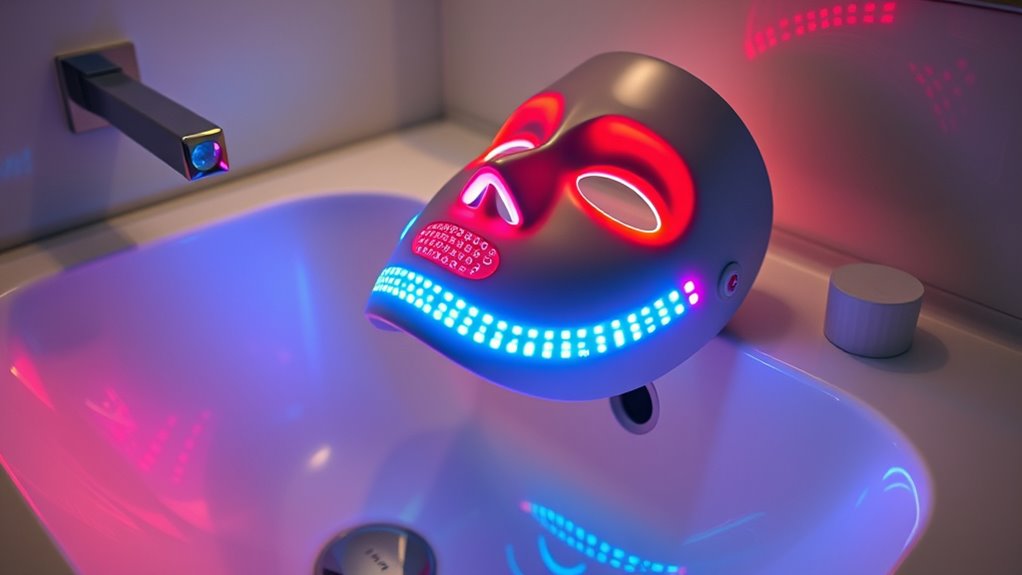
LED face masks have gained popularity as an at-home skincare solution that uses light therapy to address various skin concerns. These devices emit different wavelengths of light, typically red, blue, or a combination, to target specific skin issues. Many users turn to LED masks because they promise improvements like clearer skin, reduced inflammation, and a more youthful appearance—all from the comfort of their own homes. The idea is appealing: no need for expensive dermatologist visits or invasive procedures, just wear the mask for a set amount of time and wait for the results. While some people do see noticeable benefits, it’s important to understand what LED therapy can and cannot do.
Red light therapy is often marketed for its anti-aging properties. It’s believed to stimulate collagen production, which can help firm the skin and reduce the appearance of fine lines and wrinkles over time. If you’re aiming to combat the signs of aging, red light might offer some support, but it’s not a miracle cure. You’ll likely need consistent use over weeks or months to see meaningful results. Blue light, on the other hand, is commonly used to target acne-causing bacteria. It can be effective for mild to moderate acne by reducing bacteria on the skin’s surface, but it won’t clear up severe cystic acne or replace topical treatments prescribed by dermatologists. For other skin concerns like hyperpigmentation or uneven skin tone, some masks include additional wavelengths, but the evidence supporting their effectiveness is limited.
Red light may reduce wrinkles; blue light helps with mild acne but isn’t a cure-all.
However, LED masks don’t work for everything. They won’t replace a all-encompassing skincare routine that includes cleansing, moisturizing, and sun protection. They also don’t address underlying issues like hormonal imbalances or genetic skin conditions. If you’re dealing with deep scars, severe acne, or chronic skin problems, LED therapy alone probably won’t provide a full solution. Furthermore, while the devices are generally safe when used as directed, they aren’t suitable for everyone. People with certain skin conditions, photosensitivity, or those on specific medications should consult a healthcare professional before trying LED therapy.
Additionally, understanding the different wavelengths and their specific effects can help set realistic expectations for what LED masks can achieve. It’s also worth noting that the scientific evidence supporting the benefits of LED masks is mixed. Some studies show positive outcomes, but many of these are small or sponsored by manufacturers. Results can vary widely depending on the device’s quality, your skin type, and how consistently you use it. In the end, LED face masks can be a helpful addition to your skincare routine if you have realistic expectations. They’re not a quick fix, but with patience and proper use, they might help improve certain skin concerns. Just remember, they’re part of a broader skincare strategy—not a standalone solution.
Frequently Asked Questions
Are LED Face Masks Safe for Sensitive Skin?
Yes, LED face masks are generally safe for sensitive skin if you use them correctly. You should start with lower settings and shorter sessions to see how your skin reacts. Look for masks with gentle wavelengths, like red or near-infrared, which are less likely to cause irritation. Always patch-test new devices, follow the manufacturer’s instructions, and consult a dermatologist if you’re unsure about how your skin will respond.
How Often Should I Use an LED Face Mask?
You should use your LED face mask 3 to 5 times a week, like tending a delicate garden. This frequency allows your skin to soak up the benefits without feeling overwhelmed. Keep a close eye on how your skin reacts, adjusting use if needed. Consistency is key, but patience wins the race—think of this routine as nurturing a bloom that gradually reveals its glow.
Can LED Masks Replace Professional Skincare Treatments?
LED masks can’t fully replace professional skincare treatments, but they can complement them. You might see improvements in skin tone, texture, and acne with regular use, yet serious skin concerns like deep scars or severe aging often require expert intervention. For best results, combine LED therapy with professional advice and treatments. Always consult a dermatologist before replacing or skipping professional care, ensuring your skincare plan is safe and effective.
Are There Any Side Effects From Using LED Face Masks?
You might experience minor side effects from using LED face masks, such as skin redness, dryness, or irritation, especially if you have sensitive skin. These reactions are usually temporary and fade quickly. To avoid issues, follow the manufacturer’s instructions carefully, start with shorter sessions, and patch-test first. If you notice persistent discomfort or worsening symptoms, stop using the mask and consult a dermatologist for personalized advice.
How Long Does It Take to See Results With LED Therapy?
You’ll typically start seeing results within 4 to 8 weeks of regular LED therapy sessions. For example, if you use the mask consistently three times a week, you might notice improved skin tone and reduced wrinkles in about a month. Keep in mind, individual results vary depending on skin type and condition. Patience and regular use are key to achieving the best visible improvements.
Conclusion
So, next time you’re tempted to try an LED face mask, remember that while it might brighten your complexion, it’s not a miracle cure. Coincidentally, the best results come when you combine it with good skincare and healthy habits. Don’t rely solely on technology—your skin’s glow depends on consistent care. After all, sometimes the simplest routines, like drinking water and sleeping well, make the biggest difference in revealing your natural radiance.

